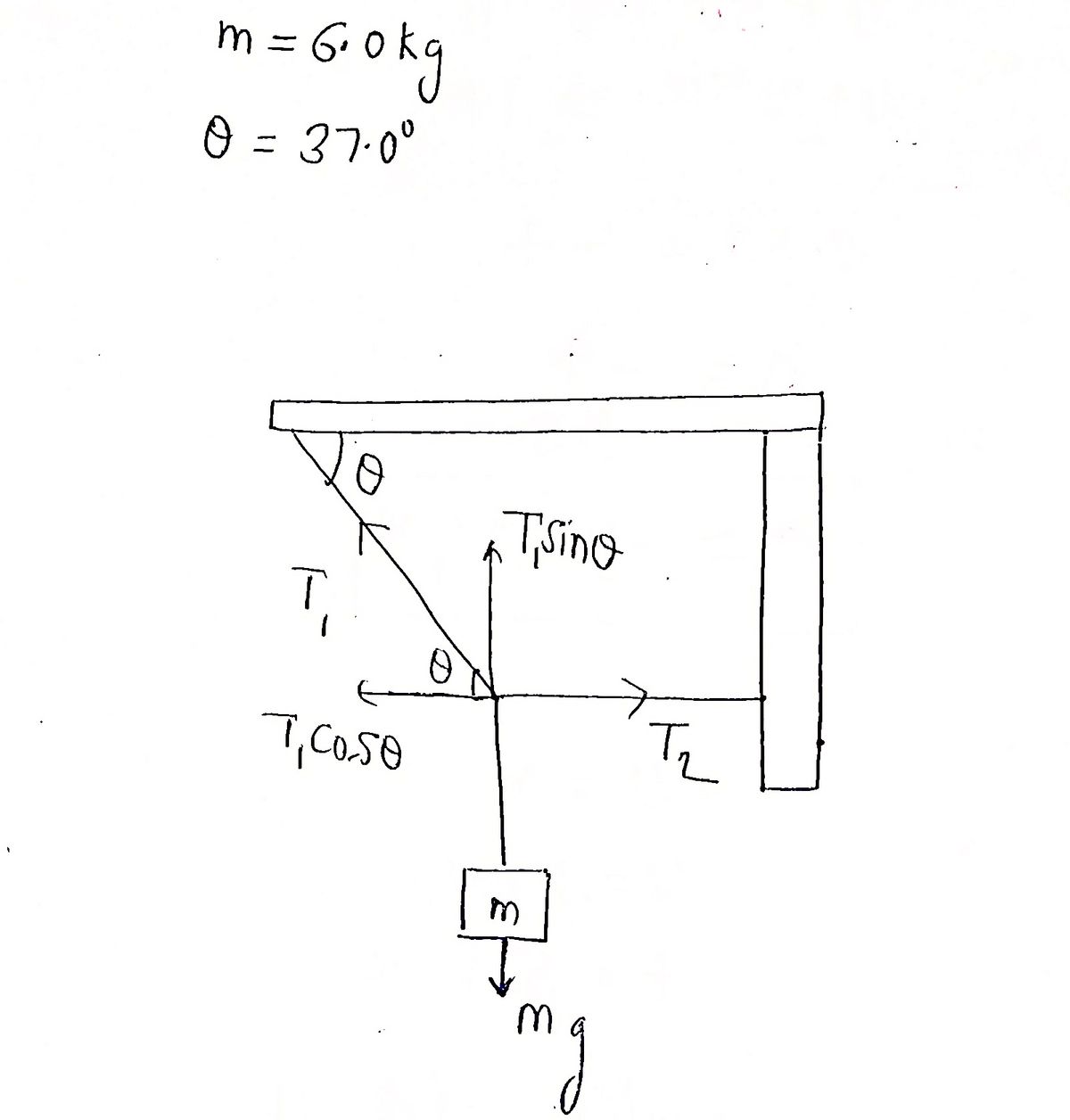A system of cables is used to support a block as shown in Figure 2 below. Find the tension in the two cables T₁ and T₂ if the mass of the block m = 6.0 kg and the angle 0 = 37.0°. Neglect the mass of the cables. (Hint: Use the conditions of translational equilibrium.) 0 T₁ Figure 2 m T₂
A system of cables is used to support a block as shown in Figure 2 below. Find the tension in the two cables T₁ and T₂ if the mass of the block m = 6.0 kg and the angle 0 = 37.0°. Neglect the mass of the cables. (Hint: Use the conditions of translational equilibrium.) 0 T₁ Figure 2 m T₂
College Physics
11th Edition
ISBN:9781305952300
Author:Raymond A. Serway, Chris Vuille
Publisher:Raymond A. Serway, Chris Vuille
Chapter1: Units, Trigonometry. And Vectors
Section: Chapter Questions
Problem 1CQ: Estimate the order of magnitude of the length, in meters, of each of the following; (a) a mouse, (b)...
Related questions
Question
Must sketch free body diagram

Transcribed Image Text:**Title: Solving Tension in Cables Using Translational Equilibrium**
**Problem Statement:**
A system of cables is used to support a block as shown in Figure 2 below. Find the tension in the two cables \( T_1 \) and \( T_2 \) if the mass of the block \( m = 6.0 \, \text{kg} \) and the angle \( \theta = 37.0^\circ \). Neglect the mass of the cables.
*(Hint: Use the conditions of translational equilibrium.)*
**Diagram Explanation:**
In Figure 2, a block of mass \( m \) is suspended by two cables. Cable \( T_1 \) is positioned at an angle \( \theta \) with the horizontal ceiling and exerts tension in the direction of the cable. Cable \( T_2 \) is horizontal, exerting tension directly to the right.
**Figure 2:**
- The diagram shows a block suspended from a point where two cables meet.
- \( T_1 \) is the tension in the left cable forming an angle \( \theta \) with the ceiling.
- \( T_2 \) is the tension in the right cable, which is horizontal.
- The block with mass \( m \) hangs directly downward from the point where the cables meet.
**Concepts Involved:**
- Translational equilibrium occurs when the sum of forces in any direction is zero.
- The forces involved include gravitational force on the block (its weight) and tensions in the cables.
**Steps to Solve:**
1. **Resolve Forces:**
- Consider the vertical and horizontal components of forces.
2. **Vertical Forces:**
- The vertical component of \( T_1 \) (\( T_1 \sin \theta \)) balances the weight of the block (\( mg \)).
- Equation: \( T_1 \sin \theta = mg \).
3. **Horizontal Forces:**
- The horizontal component of \( T_1 \) (\( T_1 \cos \theta \)) balances \( T_2 \).
- Equation: \( T_1 \cos \theta = T_2 \).
4. **Calculations:**
- Use the equations to solve for \( T_1 \) and \( T_2 \).
Understanding and applying these principles will allow you to find the tensions in the cables when
Expert Solution
Step 1

Step by step
Solved in 3 steps with 3 images

Knowledge Booster
Learn more about
Need a deep-dive on the concept behind this application? Look no further. Learn more about this topic, physics and related others by exploring similar questions and additional content below.Recommended textbooks for you

College Physics
Physics
ISBN:
9781305952300
Author:
Raymond A. Serway, Chris Vuille
Publisher:
Cengage Learning

University Physics (14th Edition)
Physics
ISBN:
9780133969290
Author:
Hugh D. Young, Roger A. Freedman
Publisher:
PEARSON

Introduction To Quantum Mechanics
Physics
ISBN:
9781107189638
Author:
Griffiths, David J., Schroeter, Darrell F.
Publisher:
Cambridge University Press

College Physics
Physics
ISBN:
9781305952300
Author:
Raymond A. Serway, Chris Vuille
Publisher:
Cengage Learning

University Physics (14th Edition)
Physics
ISBN:
9780133969290
Author:
Hugh D. Young, Roger A. Freedman
Publisher:
PEARSON

Introduction To Quantum Mechanics
Physics
ISBN:
9781107189638
Author:
Griffiths, David J., Schroeter, Darrell F.
Publisher:
Cambridge University Press

Physics for Scientists and Engineers
Physics
ISBN:
9781337553278
Author:
Raymond A. Serway, John W. Jewett
Publisher:
Cengage Learning

Lecture- Tutorials for Introductory Astronomy
Physics
ISBN:
9780321820464
Author:
Edward E. Prather, Tim P. Slater, Jeff P. Adams, Gina Brissenden
Publisher:
Addison-Wesley

College Physics: A Strategic Approach (4th Editio…
Physics
ISBN:
9780134609034
Author:
Randall D. Knight (Professor Emeritus), Brian Jones, Stuart Field
Publisher:
PEARSON